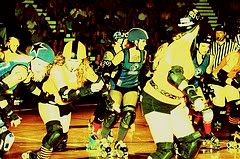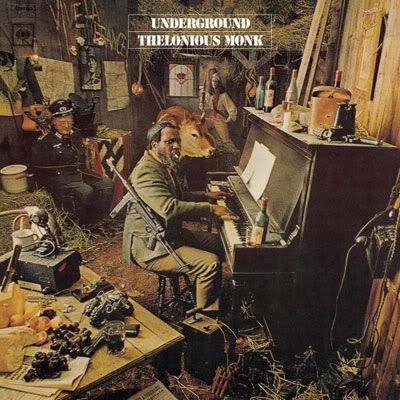(This is the first installment in a series entitled "The Analogy Project: Comparing the Incomparable.")
 |
| photo by nocklebeast |
Modern roller derby is the fastest growing sport in the pants-wearing world. Jazz is an American music style birthed in the early 20th century, whose popularity continues to grow, especially among those predisposed to pants. Roller derby and jazz share many thematic, cultural and evolutionary similarities, although a grateful nation notes that Miles Davis rarely wore booty shorts. This paragraph contained a thesis statement. Don’t get lost!
Those unfamiliar with the current roller derby trend, and remembering only the iteration that consumed middle-America in mid-century, with all of its staged fights and well-planned outcomes, might associate this jazz analogy with a cheap lounge act along the lines of Bill Murray’s infamous character on Saturday Night Live (all for show, with a definite hint of someone’s tongue in a willing cheek). “Sure,” you think, “I enjoy the entertainment, but really, since the public failure of the XFL, haven’t we been through enough?”
Persons more familiar with the sport, after attending a few rousing games, may recognize a comparison to, say, Ornette Coleman and his free jazz phase (you recognize that he won a Pulitzer, but are still trying to grasp the dissonance). At the point when you are ready cry out, “Does anyone actually know what the hell is going on here?” you start to feel a wave of appreciation and a little gratitude that you are safe as an onlooker and not a participant.
Aficionados will attest to the fact that, even if they’ve never thought about it before (and let’s be frank, not many have), this thing called roller derby is most like Thelonious Monk (it’s been around for awhile now, you’re finally paying attention to it and after a few listens every part makes sense.) You’re ready to consider yourself an expert, feel slightly more evolved than your friends, and are considering purchasing a coronet/pair of skates.
Those paragraphs furthered my premise. Are we all together? Here come the supporting statements.
Beyond the “getting it” stage, there are more parallels: some poetic by nature, others brutally physical and mortally wounding. Jazz grew up and out in its own culture of improvisation and acceptance: improvisation by necessity at the outset, and not merely a musical improvisation - playing the instruments, the methods, and the clubs available to these musical iconoclasts; acceptance not as a doctrine, but because the new form was somewhat of a catch-all and in any formative years there is little desire to thin the heard (it’s not a heard yet).
Today’s roller derby grew out of its own culture of improvisation and acceptance. Again improvisation based on availability and necessity - gear, facilities and players - in any given locale. Acceptance of size, skill and social acumen (or lack thereof) was a hallmark of early leagues proud of this non-discriminatory ideal.
Both are an amalgam of previously existing external forces, blended just so by the hands of the participants over time: African rhythms, European structure, gospel and blues; speed skating, football, hockey and oval track based motor-sports (sans motors). Somehow I’m hungry for a casserole right now. How about you?
Angst, physical and mental, existential and tangible, manifests itself, purges itself and redeems the victim and victor through manipulation of music, and/or through triumph of spirit. That is the headiest sentence in this essay. Aren’t you glad it’s behind you?
In essence, both camps morphed from the ooze of rejects, outcasts, non-conformists and rank amateurs. Jazz produced Quincy Jones. Who will roller derby spawn?
Thematically, jazz is a terrifying and brilliant double helix of melancholy and conflict, mathematics at its core, with vaguely marked road signs to point the way, in pencil, half-erased and ready for updating by the next pilot. Roller derby, in its natural state, is brilliant and conflicted, marked in two-minute increments of terror, melancholy and strategy, with one road sign, pointing left for the foreseeable future. Both are like the adage claimed by 98% of local residents of Anywhere, USA: Don’t like the weather/melody/score? Stick around – it’s bound to change.
Go to a roller derby bout for the first time and it seems like fantastic chaos, on and off the track; go to a jazz club or listen to a Blue Note record for the first time and the same is true: bursts of action, appreciation, moments of disappointment, retreat. And adult beverages. Here is a survival guide to help you through either situation:
The horn player is your jammer. He/she leads the melody, scores points and demands the most attention from the crowd. He/she also generally feels the most pressure to perform and may die of a heroin overdose (jazz) or totally freak out on you for no reason at all (derby).
The rhythm section is the pack. They play together, listen to each other and sense where every other player is going and what he/she is going to do. They play rhythm and lead/offense and defense at the same time, so pick one and watch him/her for an entire song/jam at a time to get familiar with his/her style.
The bass player is your pivot. He/she sets the pace, directs the other players and is the last line of defense. In jazz, this might mean closing the tab at the end of the night, or getting paid. In roller derby it can mean taking the heat for sucking or losing points to the opposing team. Bass players generally blame the horns for the sucking part.
The piano player is your head ref. He/she knows more about music/the game than anyone else on the track and can’t wait to tell you after the show/bout. He/she calls out players when missed cues/penalties are committed. Look for the black and white stripes.
The guy who wrote the liner notes is your announcer. He/she is a smarty-pants who doesn’t have the balls or talent to be playing, or has at birth been dealt the wrong gender or skill set. Perhaps there is a history of bad luck or injury, which he/she will point out repeatedly in the midst of some knowledgeable patter, written and/or spoken.
The audience is the audience. They will in turn cheer the competent, encourage the novice, and jeer interlopers.
And finally, unlike every other musical style and sport known to mankind, which can easily be summed up in one sentence (“Baseball is a game played by millionaires.” “Reggae is an island-style of music with a well-defined code of ambition among its devotees.”), jazz and roller derby generally require a minimum of three compound sentences to accurately describe. And even then, heads are scratched.
In summary, the thematic parallels between roller derby and jazz are unambiguous and unmistakable, once one takes the time to roll back the veils of snobbery. Roller derby is a family-friendly amusement for a Saturday night. Jazz is easy to spell and fun to say.
In summary, the thematic parallels between roller derby and jazz are unambiguous and unmistakable, once one takes the time to roll back the veils of snobbery. Roller derby is a family-friendly amusement for a Saturday night. Jazz is easy to spell and fun to say.

2 comments:
Your writing amazes me.
I'm gonna forward this one to my twin brother's girlfriend. She's a 'Roller Gal' !!
Post a Comment